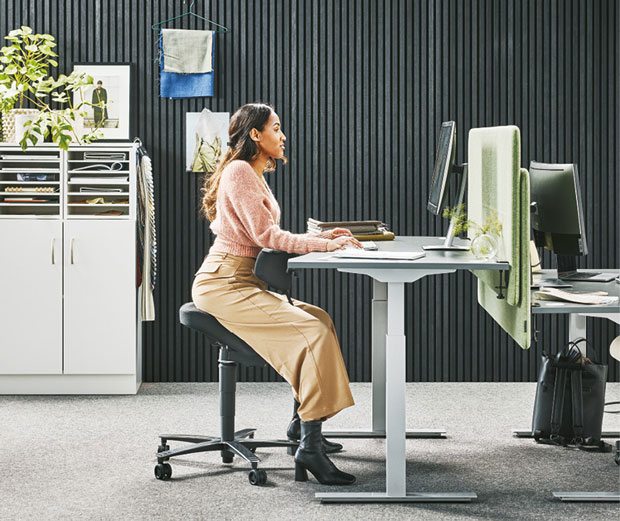MSD CAUSES
Familiar root causes of MSDs are the traditional office layout, designed for efficiency rather than health. Desk setups prioritise space saving over posture friendly layouts.
“We need to do more to naturally encourage active working habits,” Beebe suggests, “including flexible workspaces, movement friendly floor plans, and social spaces that bring people together.
“In our UK office, we’ve adopted the Swedish tradition of fika, which encourages everyone to leave their desks for a joint coffee break. Designating a set time and space for breaks makes taking a break the norm not the exception and prolongs the time spent interacting in person, which is good for our mental health while inviting movement in an achievable way. It’s a small step in the right direction.”
Encouraging active work habits to change postures throughout the day can also be achieved through movement zones – a standing meeting area or relaxation zones for breaks or creativity sessions can make in-office time more movement based. Even with more limited floor space, employees should be encouraged to stand while on a phone call or use the stairs instead of the lift. Easy adjustments can be made such as centrally locating recycling bins to promote movement.
WOMAN’S PLACE
Says Beebe: “What surprised us was our discovery that women were 1.5 times more likely than men to feel neck, back or shoulder pain on a daily basis, with 26 per cent of women experiencing pain every day compared to only 16.4 per cent of men.”
It is not clear why women are disproportionately affected by MSDs. Biological differences such as muscle composition and hormonal variations can make women more susceptible to conditions like repetitive strain injuries and postural misalignment. Many traditional office desk setups are based on standard measurements that often do not account for the ergonomic needs of female employees.
Additionally, there may be a potential correlation between women’s increased risk of burnout and the risk of stress-related pain. Studies have shown a strong correlation between job-related burnout, which women report at higher rates than men, and chronic pain syndromes, such as musculoskeletal disorders.
This is attributed to several risk factors, both inside and outside the workplace. At home, women shoulder a significantly greater share of domestic responsibilities, with the ONS reporting they undertake 40 per cent more household tasks than men. “In the workplace” Beebe explains, “many invisible workplace tasks fall to women, referred to as ‘office housework’, they take up time and compound the daily pressures.
“As we address the root cause of these disparities, there needs to be more tailored ergonomic solutions for body diversity in the workplace and an inclusive approach to workplace design.”
ERGONOMIC FURNITURE
Modern ergonomic furniture has been developed to include multiple adjustments, such as 4D armrests suitable for different body types. While the popularity of sit-stand desks has been credited with creating a more active workplace, additions such as under-desk bikes and active seating such as height adjustable wobble stools are helping to create effortless movement in the workplace.
The average person spends a phenomenal 90,000 hours in the workplace during their lifetime, and for desk-based workers, that means thousands of hours sitting. Prolonged sedentary sitting is not just related to MSDs; it is shown to be linked to slower metabolism, affecting blood sugar and circulation.
Beebe maintains: “We need to do more to support the overall health of the workforce. We have the power to design work environments that actively reduce the risk of MSDs. We can prioritise ergonomics and movement friendly layouts. Together with education, we can create proactive, sustainable work environments that prevent MSDs before they start and support long-term employee health.”





